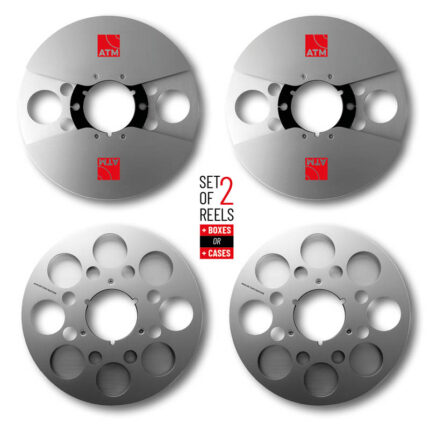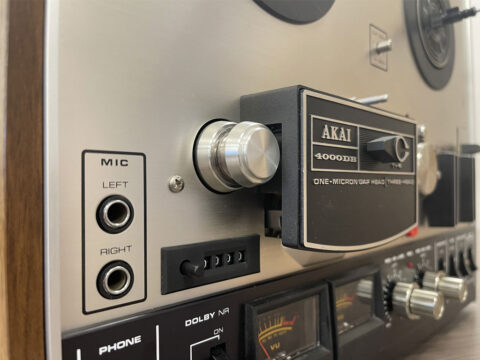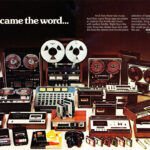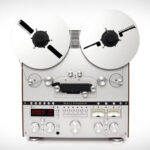Welcome to the world of reel-to-reel tapes! This classic technology has played a significant role in shaping the audio recording landscape, from its early beginnings to the present day. In this article, we will take a journey through time, exploring the evolution of reel-to-reel tapes and their enduring legacy.
The history of reel-to-reel tapes dates back to the early 1900s when Valdemar Poulsen, a Danish engineer, invented the magnetic wire recorder. However, it wasn’t until the 1930s that the first tape recorder, based on this technology, was developed by Fritz Pfleumer, a German inventor. From there on, reel-to-reel tapes became increasingly popular and played a significant role in the recording industry.
Over time, reel-to-reel tape technology continued to evolve, with advancements in design, functionality, and sound quality. Various formats of reel-to-reel tapes emerged, each with its unique features and advantages. From small portable recorders to professional studio machines, reel-to-reel tape players and recorders were widely used for audio recording and playback.
So, join us as we explore the fascinating history of reel-to-reel tapes and discover why this classic technology remains relevant today.
Key Takeaways
- Reel-to-reel tapes have a rich history dating back to the early 1900s
- Fritz Pfleumer’s invention of the tape recorder in the 1930s gave rise to the use of reel-to-reel tapes in the recording industry
- Advancements in design, functionality, and sound quality over time led to the emergence of various reel-to-reel tape formats
- Reel-to-reel tape players and recorders were widely used for audio recording and playback in both professional and home settings
- The enduring legacy of reel-to-reel tapes is a testament to their significance in the audio recording landscape
The Birth of Reel-to-Reel Tape Technology
Reel-to-reel tape technology, also known as magnetic tape recording, revolutionized the audio recording industry and paved the way for modern music production. The origins of this technology can be traced back to the late 19th century, when Danish engineer Valdemar Poulsen invented the first magnetic recorder in 1898. However, it was the German-Austrian inventor Fritz Pfleumer who developed the first practical magnetic tape recording system in 1928. His invention involved coating a long strip of paper with a magnetic powder, which could be magnetized to record sound. This magnetic tape was later replaced with a plastic backing for greater durability and flexibility. Reel-to-reel tape technology quickly gained popularity in the 1940s and 1950s, thanks to its superior sound quality and editing capabilities. It enabled recording engineers to make precise cuts and splices, allowing them to create seamless edits and layered soundscapes. Despite its early success, reel-to-reel tape technology faced several challenges, including limitations in recording time and the need for specialized equipment. However, continuous innovation and development over the years led to the creation of new tape formats and improved recording equipment, helping to make reel-to-reel tapes a staple in professional studios and home audio setups alike.Reel-to-Reel Tape Formats
Reel-to-reel tapes come in various formats, each with its own unique characteristics and applications. These formats have evolved over time, influenced by changing recording and playback technologies, as well as shifting market demands. In this section, we will explore the most prominent formats of reel-to-reel tapes and their impact on the audio industry.Mono and Stereo Tapes
The earliest reel-to-reel tapes were mono recordings, which used a single channel to capture sound. Stereo tapes, which use two channels to create a sense of depth and space in the audio, were introduced in the 1950s. Stereo tapes revolutionized the audio recording industry, allowing for a more immersive and realistic listening experience.Standard Formats
The most common standard formats of reel-to-reel tapes were one-quarter inch, one-half inch, and one inch. The one-quarter inch format was the most popular, as it provided a balance between audio quality and tape length. The one-half inch format was favored by professionals for its higher audio fidelity, while the one inch format was reserved for specialized applications such as multitrack recording.Speeds and Track Configurations
Reel-to-reel tapes come in varying speeds and track configurations. The most common speeds were 3.75, 7.5, and 15 inches per second, with higher speeds providing better audio quality at the expense of tape length. Track configurations ranged from mono to eight-track, with each track capable of holding its own audio channel. The most common track configurations were two-track and four-track, with eight-track reserved for higher-end professional use. Overall, reel-to-reel tape formats played a critical role in shaping the audio recording landscape, influencing both the quality and accessibility of recorded music and sound. While these formats may seem outdated in the digital age, they continue to hold a special place in the hearts of audiophiles and vintage recording enthusiasts.Reel-to-Reel Tape Players and Recorders
The evolution of reel-to-reel tape players and recorders has been remarkable, with significant advancements in design, features, and functionality over the years. In the early days of reel-to-reel tapes, these machines were large and bulky, with limited capabilities. However, with the advent of new technology, reel-to-reel tape players and recorders became smaller, more portable, and packed with features. One of the early reel-to-reel tape players was the Ampex 200, which was introduced in 1948. This machine was massive and heavy, weighing over 300 pounds. It was the first tape recorder capable of recording and playing high-fidelity sound, making it a game-changer for the audio recording industry. As technology improved, reel-to-reel tape machines became more compact and user-friendly. The introduction of the Nagra III in 1958 marked a significant milestone in the history of reel-to-reel tape players. This machine was much smaller and more portable than its predecessors, making it popular among reporters, filmmakers, and musicians. One of the most popular reel-to-reel tape players was the Sony TC-755, which was introduced in 1972. This machine was compact and lightweight, making it perfect for home audio setups. It featured three heads, allowing for simultaneous recording and playback, and had a variety of playback speeds. Reel-to-reel tape machines were also crucial in professional recording studios, where they were used to capture high-quality audio. The Studer A80 tape recorder, introduced in 1978, was one of the most popular machines used in recording studios. It featured advanced noise reduction technology and was capable of recording multiple tracks simultaneously. Today, reel-to-reel tape players and recorders are still in use, albeit to a lesser extent. However, they remain popular among audiophiles and music enthusiasts who appreciate the warm, rich sound that analog recordings produce. Many vintage reel-to-reel tape machines are still in use today, and they continue to inspire a new generation of music lovers.Preservation and Restoration of Reel-to-Reel Tapes
Preserving and restoring reel-to-reel tapes is crucial to maintaining the quality and longevity of these classic analog recordings. However, this is not without challenges. One of the main challenges in preserving reel-to-reel audio tapes is the slow but steady degradation of the tape material itself. Over time, the tape can become brittle and prone to breakage, which can result in the loss of entire sections of audio. To combat this, it is important to store the tapes in a cool, dry environment away from direct sunlight. Additionally, transferring the audio to a digital format can help prevent further degradation and provide a backup copy of the recording. Restoring old reel-to-reel tapes can also be a complex process. The quality of the restoration will depend on the condition and age of the original tape. The restoration process can involve cleaning the tape to remove any debris or dirt that may have accumulated over time, as well as repairing any physical damage such as torn or broken sections of tape. After this, the audio can be transferred to a digital format and further cleaned up to restore the original sound quality as much as possible. Overall, preserving and restoring reel-to-reel tapes is a time-consuming and intricate process, but it is necessary to protect these historic recordings. By taking the proper steps to preserve and restore these tapes, we can ensure that future generations will be able to enjoy the same high-quality sound that was experienced by previous generations.Conclusion
Reel-to-reel tapes have come a long way since their inception over a century ago. From their early beginnings as a simple magnetic tape for sound recording, reel-to-reel tapes have evolved into a complex recording medium that has influenced the audio industry for decades. Today, reel-to-reel tapes hold a special place in the hearts of audiophiles and music enthusiasts alike, who appreciate the warmth and authenticity that analog recordings provide. Despite the rise of digital audio technology, the charm of reel-to-reel tapes continues to endure, and their legacy remains a testament to the ingenuity and innovation of the human spirit. Although it may seem like reel-to-reel tapes are a relic of the past, they still hold relevance in the modern world. Their unique sound and aesthetic appeal continue to inspire new generations of musicians and producers, who seek to capture the magic of analog recordings in their work. As we move forward into the future, it is important to remember the contributions that reel-to-reel tapes have made to the world of audio recording. Their evolution over the years has paved the way for new technologies and techniques, and their continued preservation will ensure that their legacy endures for generations to come.FAQ
Q: What is the evolution of reel-to-reel tapes?
A: The evolution of reel-to-reel tapes involves the development and advancements in technology and formats over time. It has transformed from its early beginnings to becoming a popular medium for audio recording and playback.Q: How did reel-to-reel tape technology begin?
A: Reel-to-reel tape technology started with the invention and early applications by individuals such as Valdemar Poulsen and Fritz Pfleumer. Their pioneering work paved the way for the creation of this revolutionary recording medium.Q: What are the different formats of reel-to-reel tapes?
A: Reel-to-reel tapes came in various formats with differences in tape width, speed, and track configurations. These formats include 1/4 inch, 1/2 inch, 2 inch, and more, each with their own unique characteristics and applications.Q: How have reel-to-reel tape players and recorders evolved?
A: Reel-to-reel tape players and recorders have gone through significant advancements in design, features, and functionality. From early standalone machines to portable cassette players, these devices have played a crucial role in audio recording and playback.Q: Why is the preservation and restoration of reel-to-reel tapes important?
A: The preservation and restoration of reel-to-reel tapes are vital for ensuring the longevity and quality of these analog recordings. Proper preservation techniques and restoration processes help prevent degradation and enhance the overall audio experience.Latest Products
Recording the Masters SM900 – Pancake – 1/4″ x 10″ – 762m Backcoated
Rated 0 out of 5
ATM Reel-to-Reel Set of 2 Reels 10.5″
Rated 0 out of 5
ATM Reel-to-Reel Set of 2 Reels 10.5″+ Cases
Rated 0 out of 5
ATM Reel-to-Reel Set of 2 Reels 10.5″+ Boxes
Rated 0 out of 5
Retroreels Plastic Tape Reel Box for 10.5″ Reels
Rated 0 out of 5
































